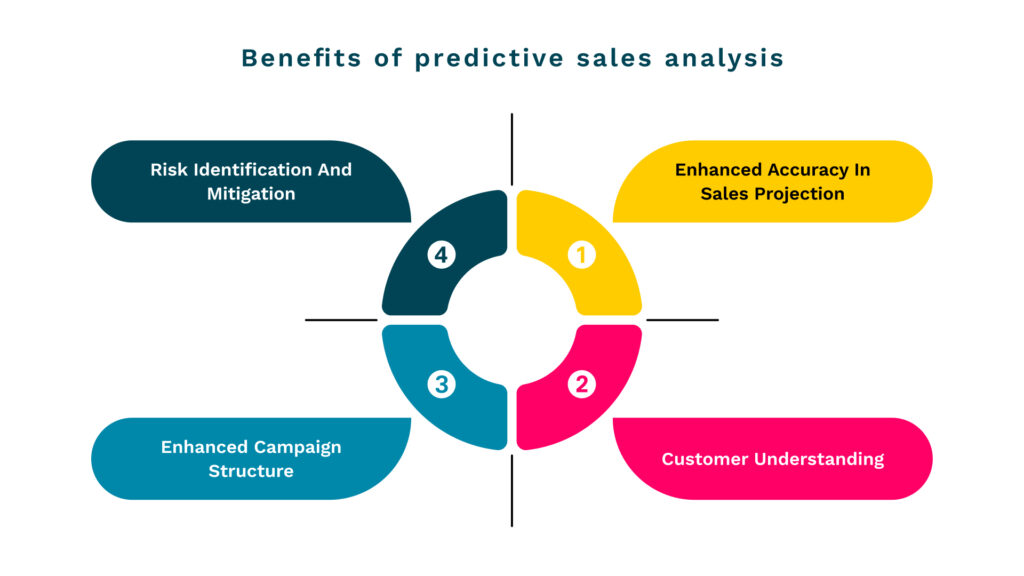
What is Predictive Sales Analytics?
Unlock the future of sales with predictive sales analytics. Harness data for smarter decisions and higher revenue. Dive into predictive insights now!
When it comes to weather forecasting, experts use historical weather patterns, current atmospheric conditions, and advanced technology to predict future weather. They anticipate whether it will rain, snow, or be sunny. The better their data points are, the better their predictions.
Similarly, Predictive Sales Analytics examines past sales data, market trends, customer behaviors, and other factors to forecast future sales outcomes. This allows organizations to make informed decisions, allocate resources effectively, and tailor their sales strategies, much like how people adjust their plans based on the weather forecast to ensure a smooth day ahead.
Let’s have a detailed walkthrough.
What is Predictive Sales Analytics?
Predictive sales analytics uses data, statistical algorithms, and machine learning techniques to forecast future sales outcomes and trends. The approach employs statistical modeling, data mining methods, and machine learning to detect patterns within diverse datasets. Predictive sales analytics studies historical sales data, customer behaviors, market trends, and other relevant factors, applying sophisticated mathematical models to forecast upcoming sales outcomes.
Predictive sales analytics has several features, including:
1. Data collection and preparation
The process begins by collecting relevant data from multiple sources. This can include historical sales data, customer interactions, website activity, marketing campaigns, and external market trends. The data is then cleaned and organized to ensure accuracy and consistency. The quality of the data directly impacts the accuracy of predictions.
2. Feature selection
In this step, the most important variables, also known as features, are identified. These features can include factors such as time of year, customer demographics, purchase history, marketing channel, and economic indicators.
3. Model building
Predictive models are built using statistical algorithms and machine learning techniques. These models use historical data to establish relationships between the chosen features and the target variable, which is typically future sales.
4. Training and testing
The built model is then trained using a portion of the historical data. This training process involves adjusting the model’s parameters to minimize errors and improve accuracy. The model’s performance is evaluated using testing data that the model has not seen before. This step helps ensure that the model can generalize its predictions to new data.
5. Prediction and analysis
Once the model is trained and validated, it is ready to predict future sales. It takes new data inputs, such as current market conditions and customer behaviors, and generates forecasts based on established patterns.
6. Actionable insights
The predictions generated by the model provide actionable insights for businesses. These insights can include forecasts of future sales volumes, identification of high-potential leads, recommendations for optimizing marketing campaigns, and insights into product demand.
7. Iterative refinement
Predictive sales analytics is an ongoing process. As new data becomes available, the model can be retrained and refined to improve its accuracy and relevance. This ensures that the predictions remain aligned with changing market dynamics.
8. Decision-making and strategy formulation
Businesses use the insights from predictive sales analytics to inform their decision-making and shape their sales and marketing strategies. For example, they can allocate resources based on anticipated sales trends, tailor marketing efforts to specific customer segments, and optimize inventory management.
Now that we have understood the process of predictive sales analytics, let’s have a look at the companies that are using this tool.
Which Companies Use Predictive Sales Analytics?
Predictive sales analytics is embraced by a diverse range of companies spanning various industries. These companies want to transform raw data into actionable insights, enabling them to anticipate customer behavior, allocate resources more efficiently, and make well-informed decisions.
Let’s see how different companies across industries are using predictive sales analytics:
1. Retail Industry
Retail companies use predictive sales analytics to forecast demand for products, optimize pricing strategies, and manage inventory levels. This helps them avoid stockouts and overstocking, ensuring they meet customer demands effectively.
2. Financial Services
Banks and financial institutions employ predictive sales analytics to assess credit risk, detect fraudulent activities, and make informed lending decisions. This results in reduced financial losses and improves the quality of loan portfolios.
3. Healthcare Sector
Healthcare organizations leverage predictive sales analytics to predict patient trends and allocate resources efficiently. It aids in optimizing hospital operations, patient admissions, and resource utilization, ultimately leading to better patient care.
4. Technology Companies
Technology firms utilize predictive sales analytics to analyze customer behavior and preferences, enabling them to tailor their products and services. This helps increase customer satisfaction and loyalty.
5. Manufacturing Sector
Manufacturing companies apply predictive sales analytics to optimize supply chain processes, anticipate equipment maintenance needs, and enhance production efficiency. This minimizes downtime and maximizes productivity.
6. Automotive Industry
Automotive companies use predictive sales analytics to anticipate market demand for specific vehicle models, allowing them to adjust production and marketing strategies accordingly.
7. Telecommunications
Telecommunication companies employ predictive sales analytics to analyze customer usage patterns and predict churn rates. It helps them design targeted retention strategies and personalized offerings.
8. Hospitality and Travel
Hospitality businesses utilize predictive sales analytics to forecast occupancy rates, optimize room pricing, and enhance guest experiences by tailoring offerings based on customer preferences.
9. Energy Sector
Energy companies leverage predictive sales analytics to predict energy consumption patterns, optimize energy distribution, and plan maintenance activities for power infrastructure.
10. Consumer Goods
Consumer goods companies apply predictive sales analytics to identify consumer trends, anticipate shifts in demand for different products, and optimize marketing strategies.
11. Real Estate
Real estate firms use predictive sales analytics to analyze property market trends, anticipate property values, and optimize pricing strategies for rental and sales properties.
12. Pharmaceutical Industry
Pharmaceutical companies utilize predictive sales analytics to forecast demand for medications, optimize inventory levels, and align production with market needs.
With so many companies using predictive sales analytics, it is important to understand what it actually does? How does it affect processes, and why is it so important?
Why Is Predictive Sales Analytics Important?
Predictive analytics software can handle complex and demanding data processes behind the scenes, allowing sales professionals to concentrate on their core strengths.
In simpler terms, predictive sales analytics assists sales professionals in transforming a potentially overwhelming volume of data into straightforward, comprehensible insights that serve the following purposes:
- Assisting salespeople in anticipating the most effective methods to engage and establish connections with prospective customers.
- Forecasting business and market trends.
- Guiding the process of setting objectives for sales teams.
Predictive sales analytics platforms also aid salespeople and marketers in determining how to optimize their existing sales pipeline by analyzing and addressing queries such as:
- Which products are performing exceptionally well?
- Which products didn’t meet projected sales?
- What types of leads progress through the pipeline most swiftly?
Predictive sales analytics empowers salespeople to leverage historical and current sales data, allowing them to stay a step ahead of both potential clients and existing customers.
Benefits of Predictive Sales Analysis
Let’s have a look at the different ways predictive sales analytics is beneficial for an organization.

1. Enhanced accuracy in sales projection
The primary rationale behind the adoption of predictive analysis by companies is to enhance the precision of their forecasting outcomes.
A comprehensive sales projection considers factors such as industry trends, historical sales data, competitors, economic fluctuations, and other pertinent sources to gauge future sales trends. However, this process is susceptible to overlooking crucial metrics without technology integration. Consequently, manually processed insights are often prone to inaccuracies.
The application of machine learning techniques serves as a remedy to this predicament. Predictive analysis meticulously evaluates each dataset, yielding actionable insights. This empowers the sales team to formulate SMART objectives (specific, measurable, attainable, relevant, and time-bound).
2. Customer understanding
Customer purchasing patterns can undergo spontaneous shifts, potentially impacting sales figures if not constantly monitored.
Predictive sales analytics delves into customer data, facilitating a more profound comprehension of their needs. It traces alterations in their requirements, enabling the strategic alignment of sales approaches.
Data-driven actionable insights reveal customer preferences, aiding in tailoring personalized pitches by the sales team. Equipped with this knowledge, customer requests can be addressed more effectively, resulting in an enhanced customer experience.
3. Enhanced campaign structure
Effective marketing campaigns play a pivotal role in driving sales. Predictive analytics empowers the identification of engagement levels, conversion rates, and campaign visibility metrics.
Additionally, it facilitates performance benchmarking against competitors, fostering learning from both their successes and failures. This process informs the design of campaigns that resonate with the intended audience, generating valuable leads.
4. Risk identification and mitigation
No enterprise is immune to risks. Economic fluctuations, geopolitical tensions, escalating fuel prices, and similar factors can positively and negatively influence business outcomes. Predictive analytics factors in diverse situational and risk-related variables during insights generation.
This proactive approach aids in risk identification and preemptive mitigation, shielding the business from severe repercussions. Addressing challenges in their early stages sustains a favorable sales trajectory and preserves market relevance.
For Predictive Sales analytics to work, the quality of data matters immensely. Error-prone data lead to wrong conclusions and poor business decisions. Inaccurate data may result in incorrect revenue forecasts, flawed market analysis, and inaccurate performance evaluation.
Nektar’s Data+ is a powerful tool that enables AI-assisted automation to make your CRM data-packed and super smart. With Nektar, you can automate enriching Opportunity Contact Roles on your CRM. You don’t have to spend hours manually updating contact roles; Nektar will do it for you automatically.
Empower Predictive Sales Analytics with Nektar
Poor CRM data translates into poor insights for revenue leaders. Nektar completely transforms the situation with CRM automation resulting in unmatched ROI.
With data-packed CRM that continuously maintains the highest data integrity. Nektar self-heals all bad, stale, or missing data.
Nektar’s proprietary machine learning abilities mean it constantly learns and improves, adapts to changes in your CRM data, and ensures everything is up-to-date and accurate. It is imperative if your business deals with large amounts of data and needs to ensure that everything is always up-to-date.
But that’s not all – Nektar can also automatically build out the buying committee map as opportunities progress. It is a game-changer for businesses that deal with complex sales cycles and multiple decision-makers.
At Nektar.ai, we are fixing the dirty CRM data problem, end-to-end by:
- Auto-capturing first-party customer information/interaction data scattered across all the sales communication channels.
- Unifying critical buying committee contact data into the CRM.
- Generating revenue signals and triggering them as notifications on Slack/Email.
Want to know more about us and our AI for RevOps solutions? Talk to our team.
PUBLISHED BY






